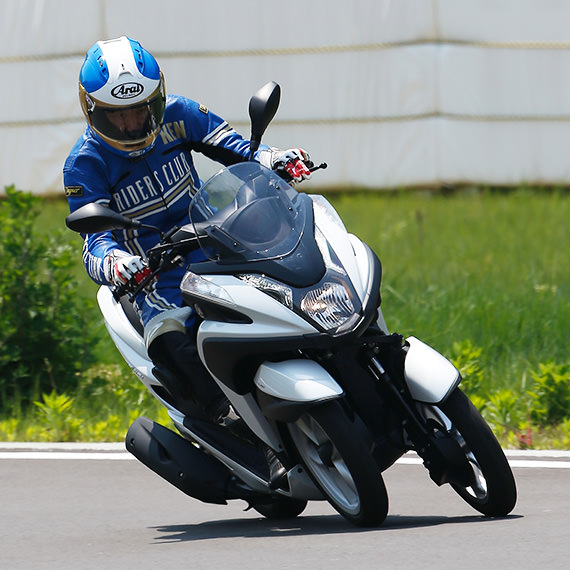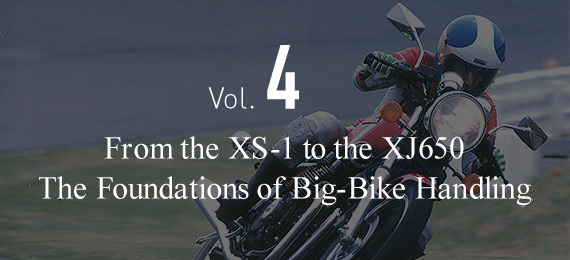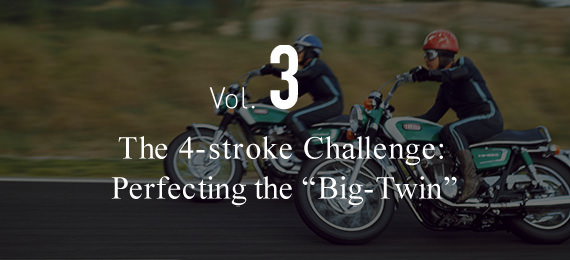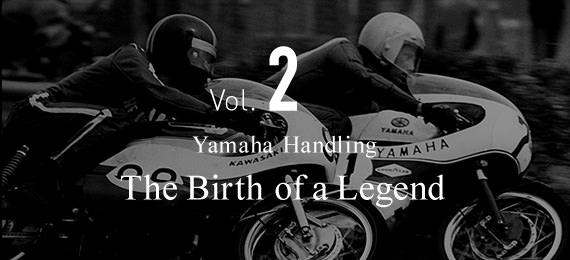Vol.1 Yamaha Handling From the racetrack to the street. TRICITY
What's the image you have of the manufacturer, Yamaha Motor? For me, someone who was the editor in chief of a motorcycle magazine for over 35 years, my image of Yamaha has been one of a brand that values handling above all. We called the results of this, "Yamaha Handling." High performance is definitely one of the appeals of a motorcycle, but Yamaha always placed their priorities on performance characteristics that a rider could quickly feel comfortable with. No matter how high the performance numbers may be, if the performance itself isn't easy to use and prone to sudden and abrupt changes, it'll only make the rider tense and always on guard. Especially for a beginner, unpredictable performance can cause them fear. To really enjoy the ride, it's essential that the machine's characteristics be well-tempered and feel natural to rider perceptions. Throughout its history, Yamaha has always built motorcycles based on that belief. What is considered "natural handling" that makes the machine easy to ride has also changed slightly with the times. Following those changes over the years paints a clear picture of just how advanced today's motorcycle development is. Before reviewing this history, let's look at the handling of the TRICITY, a new type of vehicle born of this tradition of "Yamaha Handling."
Ken Nemoto
Born in Tokyo, Japan in 1948.
Withdrew from Keio University's Faculty of Letters.
He began riding motorcycles at age 16, won the 750cc All Japan Road Race Championship title in 1973 and competed in the World GP from 1975 to 1978. After returning to Japan, he served as the editor in chief of RIDERS CLUB magazine for 17 years and also served in producing a wide variety of hobbyist magazines. Today, he competes in the AHRMA's classic motorcycle races at Daytona Speedway as part of his life work.
Didn't See That Coming! Handling on Par with a Sport Bike
Yamaha Motor recently unveiled an entirely new commuter model called the "TRICITY." It's a global model that was first released in Thailand—where it's also manufactured—and will be available in Europe and Japan in the near future.
The first thing to note about this new model is that it's a 3-wheeler, with two wheels in front and one drive wheel in the rear, but the chassis and all three wheels lean together when going through turns like a normal 2-wheeled motorcycle. It's also not free-standing, so if the stand isn't put down when parked or if you don't put your foot down when stopped, the machine will fall over. If this is the case, many people might ask what the purpose of the third wheel is.
The TRICITY really is the result of a high-level and quite challenging project that's not bound by the ideas of what a standard commuter model should be: to build a vehicle that handles in a completely new way while still being operated like a bicycle or motorcycle.
I say all this in retrospect, because I didn't realize what an innovative machine it was until I actually got on and took it for a test-ride myself.
Since offering proof serves better than theoretical arguments, let me begin by describing the shocking revelations I discovered in the actual test-ride.
First of all, seeing the actual machine and its two front wheels side by side instead of the usual single wheel brought with it an unusual feeling. It's something you're simply not used to seeing and gave me no hints about what it would feel like to ride.
As I started out and headed into the first turn, I was astonished at how unexpectedly natural the ride felt. Then, as I tested its performance by making right and left turns, applying the brakes with considerable force, etc., I was surprised again to find that there was basically no major difference from the feeling of a conventional motorcycle.
So...why two front wheels?
The more I rode it and took it through a variety of situations, the more the benefits of the two front wheels gradually began to show.
First, there's the good feeling of contact with the road from the front wheels. I can already hear some people asking why that even matters for a commuter bike meant for city streets, but whether the average rider is conscious of it or not, there's always a feeling of firm road contact from the front wheels, and there's no lag in the steering response when you begin to enter a turn. I got a glimpse at where these two front wheels really work well.
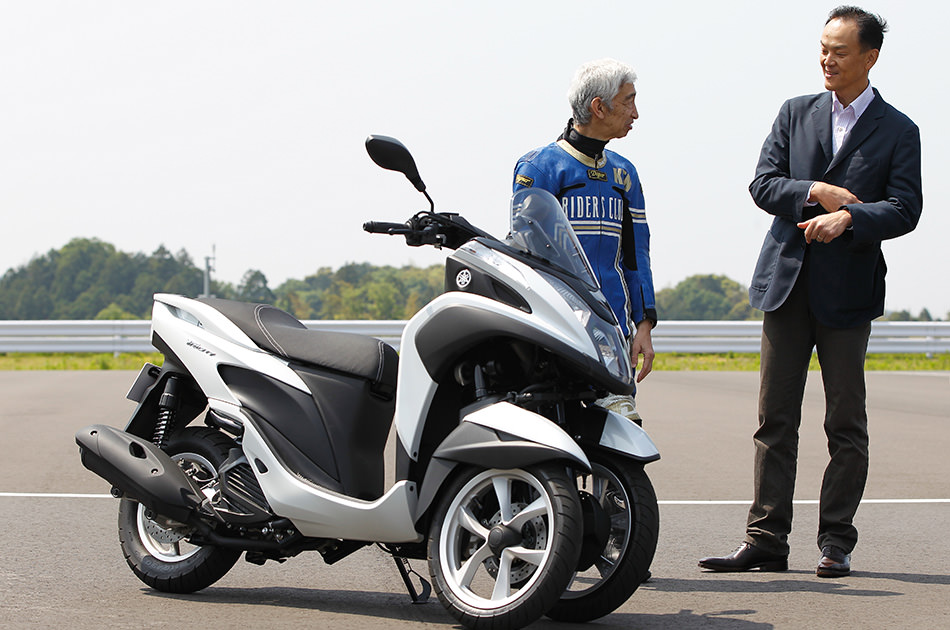
At Yamaha's Kikugawa Test Course, Ken Nemoto prepares to test-ride the TRICITY as Project Leader Kazuhisa Takano prompts him to "please hop on and give it a try."
Here I'm afraid I have to use some terms meant to describe the performance of a superbike, but this is an important area, so please bear with me. When you take a motorcycle through a turn, you lean the machine into the turn and go through it using both the front and rear wheels. When doing so, what happens between the steerable front wheel and the rear wheel that's fixed in the direction of the chassis? The rear wheel leans and travels along an arched line through the turn, and the front wheel follows a corresponding arched line that runs slightly outside it. The smoother the compliance of this relationship is, the more confidence and riding ease the rider feels.
Therefore, the prime objective is to have good tracking performance by the front wheel with regard to the lean, etc., of the rear wheel. So, even if you wanted to use extra wide tires in order to maintain grip during hard braking, this becomes wholly detrimental because you would lose the quick response you need when leaning the machine into a turn. That's why despite the rear tires on motorcycles in MotoGP, World Superbike, etc., becoming exceptionally wide in recent years, there have been no major changes in the size and profile (cross-section) of the front tires in over 30 years. Even with top-end MotoGP machines, you can't sacrifice the ease of handling a rider feels.
If that's the case, adding a second front wheel with the same profile would surely bring a improvement in performance from braking to corner entry without sacrificing ease of use, and it enhance grip when going over rough road surfaces and the like. In other words, you can feel how different the TRICITY's sporty performance is from a conventional commuter model, and that symbolic difference lies in the factors above.
The more I test-rode it, the more I found myself riding aggressively, even though it's meant to be a commuter vehicle. I imagine I must have looked a bit ridiculous to someone watching who doesn't know what it can do.
But, this was no time to worry about how I might have looked to somebody else. The ability of the machine to tolerate hard braking during turns was equal to or even better than a sport bike, even though it wasn't fitted with high-grip tires like a sport bike would be. Also, the response of the front wheels when leaning into a turn was very quick. It was especially fun when making tight turns like in a hairpin. Even at speeds where a scooter would not be able to hold the line and lowside, the TRICITY showed it could make the turn with the front and rear wheels both functioning well. I really became absorbed in the excitement of my first experience with a twin-front-wheel machine.
I noticed something else when riding straight forward and going over something like a seam in the pavement. This is something that can cause the handlebars to jerk on a machine with small-radius tires like a scooter and you have to be prepared for it, but with the TRICITY, I was left stunned over and over with how it held such a smooth, stable and straight course because of its two front wheels. In short, the TRICITY even makes situations like this that you may feel difficult to deal with on a conventional motorcycle especially interesting and enjoyable to ride.
What makes this kind of light, agile and sporty performance and easy-to-ride character possible is the TRICITY's "parallelogram link" mechanism and its left-right independent "cantilevered telescopic suspension." This exclusive Leaning Multi Wheel (LMW) structure that allows the two front wheels to lean together with the chassis has been developed to a startlingly high level of sophistication, despite being the first attempt of its kind by Yamaha Motor.
The 125cc engine with CVT (continuously variable transmission) provides unexpectedly lively performance, and the model's overall length of 1,905 mm and width of 735 mm makes it slightly larger than a scooter of the same displacement, but machine weight has been kept to the equivalent of a 150cc scooter at 146 kg, despite the complex structure of the front end. If it were larger and heavier, it would not be commonly accepted as a commuter vehicle, no matter how innovative the ride might be. I believe that the size Yamaha has chosen for its first attempt at this kind of 3-wheeler is right on target.
(Continue to Part 2)
